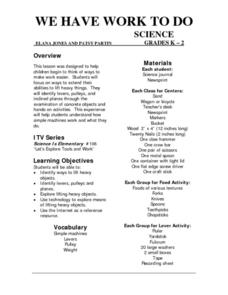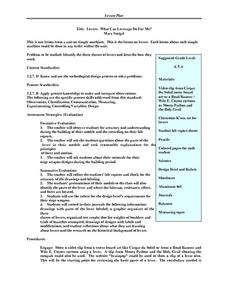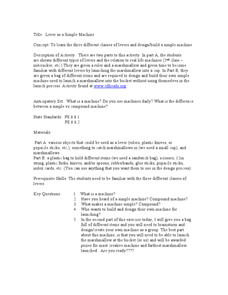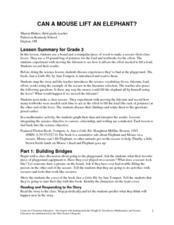Curated OER
What is a Class One Lever?
Fifth graders understand what a lever is, how it works and what the parts of a lever are. For this first class lever lesson, 5th graders label pictures and design a lab lever. Students predict the outcome of experiments with their lever...
Curated OER
Positioning the fulcrum in class one levers
Students explore the relationship between force and the distance of the load from the fulcrum. In this experimental activity students get into groups and make a lever and record the force that is needed to move it, they then try this...
Teach Engineering
Levers that Lift
Introduce your class to to the remaining three simple machines-- the lever, pulley, and the wheel-and-axle with a plan that includes the three different types of levers in the discussion of levers. The lesson continues with the...
Curated OER
Learning the Basic Levers...One, Two, Three: Different Basic Arrangements Levers
Fifth graders read information about levers. They complete worksheets to summarize their learning. This lesson relies heavily on the Silver Burdett Ginn text, Science Discovery Works, Energy, Work, and Machines. The lesson will not be...
Curated OER
We Have Work to Do!
An excellent lesson plan awaits your young scientists! In it, learners are invited to explore the world of pulleys, levers, and planes; simple machines that make lifting heavy things much, much easier. They watch video, and engage in...
Agriculture in the Classroom
Six Kinds Do It All
Teach young engineers that all machines, no matter how complicated or complex, are made up of just six simple devices with this hands-on physical science lesson. Using the included templates, students first create paper models of...
Curated OER
Levers: What Can Leverage Do For Me?
Students determine the identity of the three classes of levers while explaining how each works. They wait a video clip that shows uses for different types of levers and work as a class to write a KWL chart. Finally, they make a model fo...
Curated OER
Is a Pulley a Special Kind of Lever?
Fifth graders use information from their text to read and discuss pulleys and levers. They examine a top sketch of the arrangement of a fixed pulley. Working in groups, 5th graders perform experiments to test the effect of using a pulley...
Curated OER
Lever as a Simple Machine
Young scholars study the three different types of levers and develop a simple machine. In this levers and simple machines lesson, students look at different types of levers, and experiment with a ruler and a marshmallow to determine how...
Teach Engineering
The Advantage of Machines
Show your students how to make their work easier. The first lesson in a series of 10 introduces the class to work and the way simple machines can be make work easier. The simple machines scholars can find in everyday items are inclined...
Teach Engineering
Not So Simple
Compound machines, nothing more than a combination of simple machines working together, are the focus of an activity that asks class members to use the provided information to take a look at the way innovators combine simple machines to...
Curated OER
Simple Machines III - Pulleys
The principles behind pulleys, levers, and simple machines are the focus of a science lesson. In it, learners take part in a whole-class activity. There are two groups of pupils who each must lift objects with fixed pulleys and multiple...
Curated OER
Secrets of Lost Empires II -- Medieval Siege
Students design a working working model of a trebuchet and demonstrate the power of a Class 1 lever. They test their models by throwing grapes the greatest distance and raising and lowering bricks.
Curated OER
Designing and Building Catapults
Seventh graders complete a challenge to create a catapult that projects a marble or other projectile at least one meter. While experimenting they apply the Four Question Strategy to answer the question, " How can I make one modification...
Curated OER
Can a Mouse Lift an Elephant?
Read Just a Little Bit, by Ann Tompert as an introduction to levers. Discuss playground seesaws and then turn learners loose to experiment with the placement of a fulcrum. Their goal is to determine where to place it in order to lift ten...
Curated OER
Levers
Young scholars brainstorm if they think that any lever would use the same amount of paperclips. They break into small groups and use a data sheet as well as a lever, Lego person, fulcrum, and some paperclips and prove what they think by...
Curated OER
Pulleys and Levers
Fifth graders explore the concept of pulleys and levers. They read and discuss text from the book "It's Science! Machines We Use," and in small groups construct a simple lever and pulley using a Lego Dacta set.
Curated OER
Inverse (Indirect) Machines
Students observe relationships between quantities. Students complete activities for three different classes of levers. In groups, students build each type of lever. Students identify levers in their daily surroundings. Students observe...
Cornell University
Catapult
Studying levers couldn't be more exciting! Learners build their own catapults and test the results as they make adjustments to the fulcrum. They compete against other groups to create the most accurate apparatus.
Curated OER
How Does the Elbow Work: A lesson in Levers
Students examine levers that exist in the human body. In this body function lesson students complete a lab activity that models how the elbow is a third class lever.
Curated OER
Levers: Catapults
Students construct a catapult that shoots a cotton ball at least two meters using Legos, rubber bands, and plastic spoons. They discuss how the catapult works, and identify any problems they had with their experiment.
Curated OER
Using Fulcrums
Students engage in a lesson that concentrates on the use of a lever and fulcrum. They define how a lever is used to lift a load. The lesson has background information to justify it. Students demonstrate how to use the lever while lifting...
Curated OER
Smoses Toy Expo
Students research one of the simple machines listed in the lesson and review several simple machine websites to complete their research. Students use software and a watch a video to learn more about machines. Students create a poster...
Curated OER
Secrets of Lost Empires II-Pharaoh's Obelisk
Young scholars identify and analyze how levers work by raising a brick with a shish kebab skewer. Students present their work, explaining what did and did not work, including illustrations of the lever lift from different angles. Young...

























